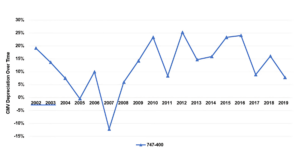
April 21, 2020
Historical Values Trends of Commercial Aircraft Over Time
by Ryan Cross with values commentary by Alex Cosaro
mba has earned its reputation as a world leader in valuations for a variety of assets types, spanning commercial aircraft, engines, helicopters, spare parts, corporate jets and more. mba’s team of ISTAT Certified Appraisers conducts over 5,000 valuations annually for more than 200 clients. Drawing upon the strength of its historical values dataset, which spans back to the 1990s, these appraisers update mba’s aircraft values quarterly.
The coronavirus (COVID-19) pandemic highlights the need among industry decision-makers for reliable data. As aircraft investors contemplate the future of their owned assets, for example, scrutiny of their aircraft’s value over time helps to quantify how values might fall in the near future. For the sake of comparison, mba’s expert analysis illuminates how asset values have performed during and after previous shocks to the market.
In the last two decades, three noteworthy trigger events sparked downturns in the commercial airline business: the terrorist attacks of 2001, the severe acute respiratory syndrome (SARS) outbreak of 2003, and the global financial crisis of 2007-2008. The economic chaos caused by COVID-19 will surely cause another slump in aircraft values.
Popular Narrowbody Aircraft
9/11 had a greater impact on Market Values of the Airbus A320-200 than the Boeing 737-800 due to overproduction of the Airbus product at that time. This was due to Airbus lacking the ability to scale back production due to French labor laws, which led the company to produce “white tails,” or planes produced without a customer. Airbus has since become more flexible with the construction of new assembly lines in Tianjin, Mobile, and Hamburg.
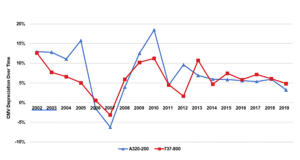
50-Seat Regional Jet Aircraft
50-seat regional jet values were greatly affected by scope clause renegotiations, which allowed for larger and heavier aircraft to be flown by regional carriers in the United States. CRJ-200 values depreciated rapidly in 2006 due to the bankruptcy of Independence Air, which operated 68 CRJ-200s at the time it ceased operations.
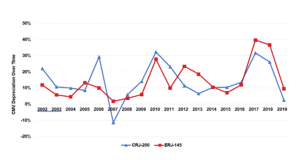
Turboprop Aircraft
Turboprop Market Values tend to depreciate at a slower rate than their regional jet counterparts and have been bolstered in the past by increasing fuel prices, making them more attractive to cost-conscious operators. ATR 72-500 Market Values have taken a hit in recent years due to oversupply in the secondary market.
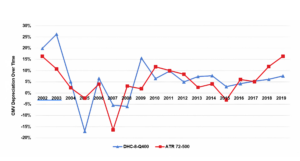
A33ceo Aircraft
The Market Values of widebody aircraft tend to depreciate faster than narrowbody aircraft in times of crisis, with in-production widebody aircraft taking less of a hot than out-of-production aircraft. This can be seen in the chart below, with the A330-300 and A330-200 depreciating between 10% – 20% during 9/11 and the financial crisis.

Selected Widebody Aircraft
Comparatively, the older 767-300ER and MD-11 depreciated between 25% – 30% during the same time periods. This effect is likely to continue in the current COVID-19 crisis.
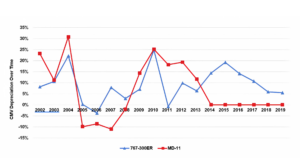
747-400 Aircraft
Four engine widebody aircraft have fallen out of favor with operators in recent years due to high maintenance and reconfiguration costs, coupled with the continued performance improvements of twin engine widebody aircraft. This has led to high average yearly depreciation, as detailed below with the 747-400.
